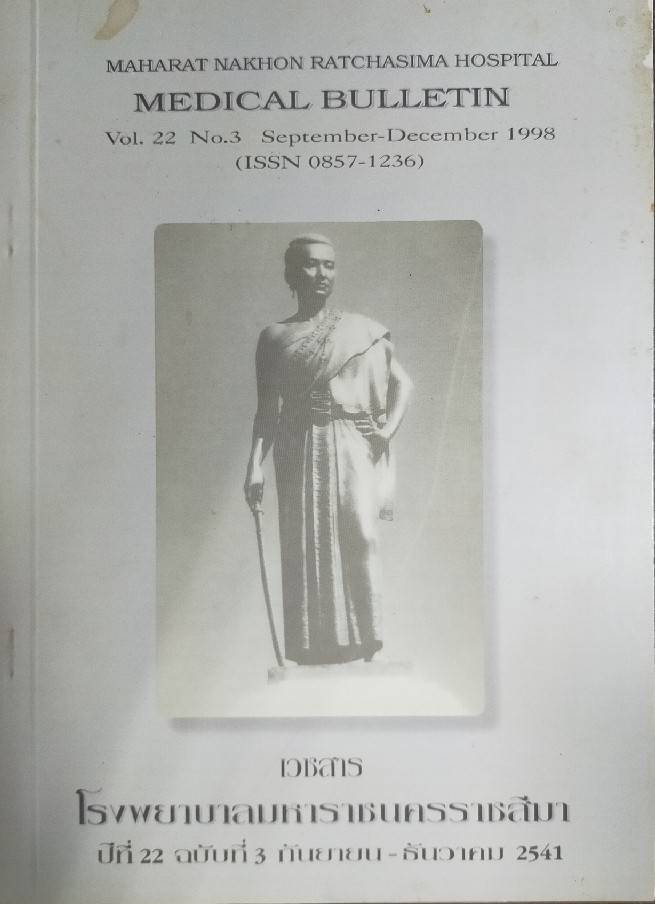The Experience of Rabies Post-exposure Treatment in Pakchong NaNa Hospital
Main Article Content
Abstract
The purpose of this study was to assess the rabies exposure and treatment in Pakchong NaNa Hospital during September 1, 1996 to August 31, 1997. There were 567 patients with 306 males and 261 females. Patients aged less than 10 years had the highest incedence rate. Patients who had been bitten with or without bleeding were 86.36%. The upper and lower limbs were injured 60.98% of all exposures. Holding, stepping on and playing with dog were the first three common causes of exposure, with 31.76%, 22.36% and 12.94%, respectively. Domestic dogs had received rabies vaccine only 6.35%. Patients who had properly cleansed theirs wounds before seeking medical attention were 34.39%. Complication of vaccination (2.5%) were headache and limb pain. The dogs with abnormal symptoms might be assumed to be rabid. Prevention of rabies in dog was under performe even though it is the primary measure for combating rabies worldwide. Only 12.87% of the treatments were correct according to WHO recommendations. After exposure, physician or local health officers should educate patients and help them evaluate the risks and benefits of the treatment.
Article Details

This work is licensed under a Creative Commons Attribution-NonCommercial-NoDerivatives 4.0 International License.
References
Steel JH, Fernandez PJ. History of rabies and global aspects. In: Baer GM, ed. The natural history of rabies. 2nd ed. Boca Raton, Fla.: CRC Press, 1991:1-26.
Swaddiwudhipong W, Tiyacharoensri C, Singhachai C, Chutivongse S. Epidemiology of human rabies post-ex-posure prophylaxis in Bangkok, 1984-1986. Southeast Asian J Trop Med Public Health 1988;19:563-9.
Tsiang H. Pathophysiology of rabies virus infection of the nervous system. Adv Virus Res 1993;42:375-412.
Koprowski H. Visit to an ancient curse. Sci Am Sci Med 1995;2:48-57.
Blancou J, Aubert MFA, Artois M. Fox rabies. In: Baer GM, ed. The natural history of rabies. 2nd ed. Boca Raton, Fla.: CRC Press, 1991:257-90.
Baer Gm, Shaddock JK, Quirion R, Dam TV, Lentz TL. Rabies susceptibility and acetylcholine receceptor. Lancet 1990;335:664-5.
Rung pitarangsi V, Oonsombat P, Yongchaiyudha S, Attanatho V, Sonjai A. The experience of rabies prophylaxis in Siriraj Hospital 1980-1987. Siriraj Hos Gas 1989;41: 537-41
Rabies prevention-United States, 1991: recommendations of the Immunization Practices Advisory Committee (ACIP). MMWR Morb Mortal Wkly Rep 1991;40(3):1-19.
Healthy people 2000: national health promotion and diseases objectives. Washington DC: Public Health Service;1990:122. DHHS publication PHS 91-50213.
Dean DJ, Baer GM, Thomp WR. Studies on the local treatment of rabies infected wounds. Bull World Health Organ 1963;28:477-86.
Wide H, Chutivongse S, Tepsumethanon W, Choomkasien P, Polsuwan C, Lumbertduaecha B. Rabies in Thailand 1990. Rev Infect Dis 1991;13:644-52.
Mc Kendrick AG, A ninth analytical review of reports from Pasteur Institutes on the results of anti-rabies treatment. Bull Health Organization League Nations 1949:31-78.
Perry GF Jr. Occupational medicine forum. JOM 1993;35:884-5.
World Health Organization. Expert Committee on Rebies. Technical Report Series: 824 Geneva, WHO, 1992.
Fishbein DB. Rabies in humans. In: Baer GM, ed. The natural history of rabies. 2nd ed. Boca Raton, Fla.: CRC Press, 1991: 519-49.
Veeraraghavan N, Cajanana A, Rangasami R, et al. Studies on the salivary excretion of rabies virus by the dog from Surandai. Scientific report 1968. Coonour: Pasteur Institute Southern India, 1969:68-70.
Aghomo HO, Rupprecht CE. Further studies on rabies virus isolated from healthy dogs in Nigeria. Vet Microbiol 1990;22:17-22.


